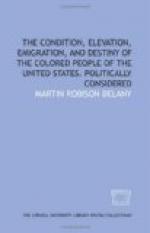It is notorious, that in the planting States, the blacks themselves are the only skillful cultivators—the proprietor knowing little or nothing about the art, save that which he learns from the African husbandman, while his ignorant white overseer, who is merely there to see that the work is attended to, knows a great deal less. Tobacco, cotton, rice, hemp, indigo, the improvement in Indian corn, and many other important products, are all the result of African skill and labor in this country. And the introduction of the zigzag, or “Virginia Worm Fence,” is purely of African origin. Nor was their skill as herdsmen inferior to their other attainments, being among the most accomplished trainers and horsemen in the world. Indeed, to this class of men may be indebted the entire country for the improvement South in the breed of horses. And any one who has travelled South, could not fail to have observed, that all of the leading trainers, jockies, and judges of horses, as well as riders, are men of African descent.
In speaking of the Bornouese, a people from among whom a great many natives have been enslaved by Arabian traders, and sold into foreign bondage, and of course many into this country, “It is said that Bornou can muster 15,000 Shonaas in the field mounted. They are the greatest breeders of cattle in the country, and annually supply Soudan with from two to three thousand horses."... “Our road lying along one of them, gave me an excellent view of beautiful villages all round, and herds of cattle grazing in the open country."... “Plantations of cotton or indigo now occupy the place where the houses formerly stood."... “The Souga market is well supplied with every necessary and luxury in request among the people of the interior.” “The country still open and well cultivated, and the villages numerous. We met crowds of people coming from Karro with goods. Some carried them on their heads, others had asses or bullocks, according to their wealth."... “The country still highly cultivated."... “We also passed several walled towns, quite deserted, the inhabitants having been sold by their conquerors, the Felatohs.” “Women sat spinning cotton by the road side, offering for sale to the passing caravans, gussub water, roast-meat, sweet potatoes, coshen nuts,” &c. (Dunham and Clapperton’s Travels and Discoveries in North and Central Africa, vol. 2, pp. 140, 230, 332, 333, 353.)
The forests gave way before them, and extensive verdant fields, richly clothed with produce, rose up as by magic before these hardy sons of toil. In the place of the unskillful and ill-constructed wigwam, houses, villages, towns and cities quickly were reared up in their stead. Being farmers, mechanics, laborers and traders in their own country, they required little or no instruction in these various pursuits. They were in fact, then, to the whole continent, what they are in truth now to the whole Southern section of the Union—the bone and sinews of the




